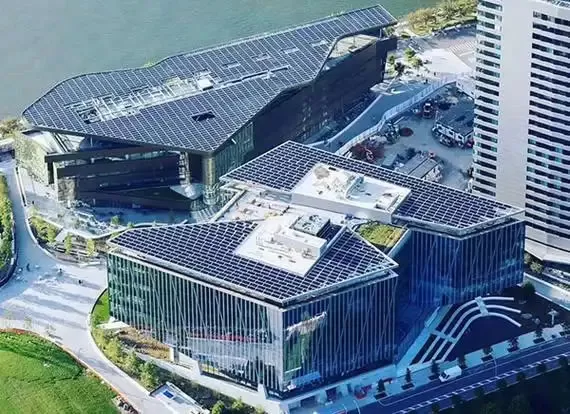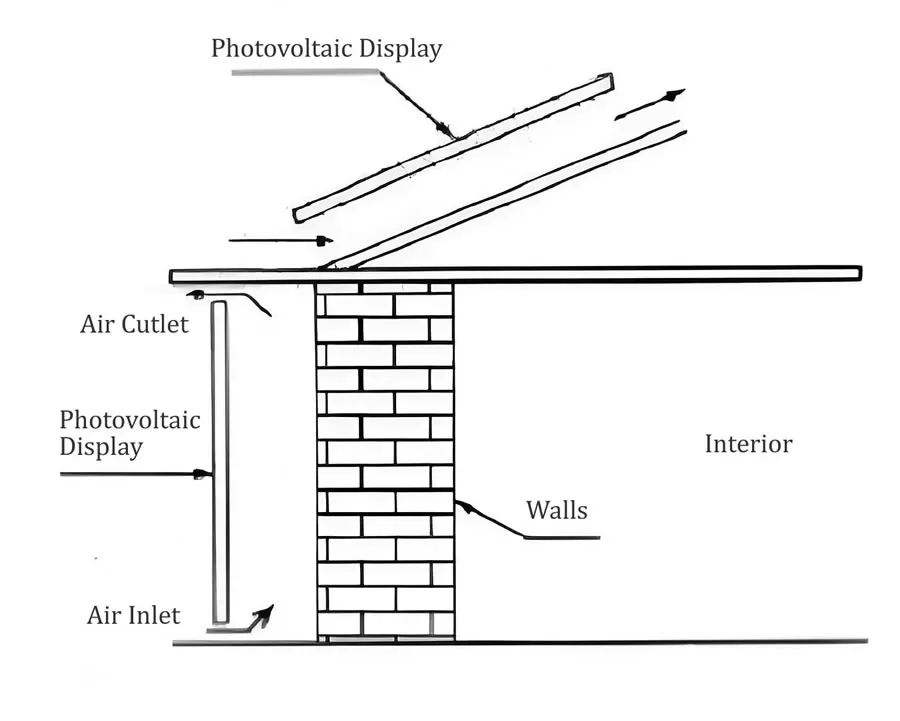
As the global energy crisis and environmental pollution become more and more serious, the combination of green building and renewable energy has become a new trend in the construction industry. Building Integrated Photovoltaic (BIPV), as an emerging sustainable technology and a model for integrating clean energy and building design, is bringing innovative energy solutions to buildings. By integrating solar photovoltaic (PV) systems into the building structure, BIPV not only provides an efficient way of utilizing energy, but also helps buildings to achieve energy self-sufficiency and contribute to environmental protection.Brice Solar will provide an in-depth analysis of the prospects, advantages and successful cases of the application of PV building integration technology, and help you to understand how BIPV can become a “power station” for the future of buildings. “Power Station”.
1、What is BIPV (Building Integrated Photovoltaic)?
BIPV (Building Integrated Photovoltaics) is a technology that closely integrates photovoltaic systems with building structures, unlike traditional photovoltaic systems (BAPV, i.e., rear-mounted photovoltaic), replacing traditional building materials such as glass curtain walls, roof tiles, and sunshade panels, and realizing unification of power generation function and architectural aesthetics, with the photovoltaic module replacing the traditional building materials and become part of the building. Unlike traditional rooftop solar panels, BIPV does not just add additional power generation devices, but organically combines the solar power generation system with the function, appearance and structure of the building, so that the photovoltaic modules can provide power while realizing architectural functions such as aesthetics, heat insulation and waterproofing. Its core advantages are:
Zero-occupancy power generation: utilizing building surface space without taking up additional land resources;
Reduced costs and increased efficiency: saving building material costs, while reducing energy consumption throughout the life cycle of the building through power generation;
Green certification plus: meets the requirements of LEED, WELL and other international green building ratings, and enhances asset value.
2、The core technology analysis of BIPV

Schematic diagram of photovoltaic building integration
Photovoltaic Module Core Technology
The core of BIPV technology lies in the selection and integration of PV modules. While traditional PV panels usually use monocrystalline or polycrystalline silicon, BIPV requires PV modules that not only have high efficiency in power conversion, but also need to have the appearance and functions that are compatible with building materials. Nowadays, with the advancement of technology, new types of modules, such as thin-film PV and transparent PV, are gradually applied to BIPV, providing more design space and functional choices.
Photovoltaic Integrated Design and Construction Technology
The design of BIPV is not only about the installation of PV modules, but also about how to integrate the PV system with other systems of the building, such as utility networks and ventilation equipment. In terms of construction, it is necessary to take into account the building's load-bearing capacity, waterproofness, light transmission and other factors to ensure that the PV system can be perfectly integrated with the building structure.
Application of photovoltaic energy storage system
The combination of photovoltaic power generation system and energy storage system is another highlight of BIPV system. The electricity generated by solar PV systems during the day can be stored by the energy storage system for use at night or for power supply under unstable weather conditions. By optimizing energy storage technology, BIPV buildings are able to achieve efficient use of energy and intelligent scheduling.
Intelligent Management and Monitoring
With the development of IoT technology, the intelligent management of BIPV systems is getting more and more attention. The intelligent management system can monitor the power generation efficiency of PV modules, energy storage status, power consumption, etc. in real time, and dynamically adjust it according to the actual needs of the building to realize the maximized utilization of energy.
3、The advantages of BIPV
Green and environmental protection, reduce carbon emissions
As a clean energy technology, BIPV reduces dependence on fossil energy by utilizing solar energy as a renewable resource, helping to reduce the carbon footprint of buildings and promoting the transition of the construction industry to green and low-carbon.
Saving Energy and Reducing Energy Consumption
By integrating solar power systems directly into buildings, BIPV not only provides clean power to buildings, but also enables them to be self-sufficient, reducing reliance on electricity suppliers and significantly lowering energy costs for building operations.
Aesthetics and Functionality
BIPV technology offers a variety of design options. The appearance of the PV modules can be customized according to the architectural style, which ensures that the building is both aesthetically pleasing and practically functional, such as waterproofing, heat insulation, noise isolation, and so on.
Increased building value
Buildings with integrated PV systems not only save on energy costs, but also increase the market appeal of the building. With the popularization of green building and sustainable development concepts, the market demand for BIPV buildings is growing and can bring more return on investment for building owners.
4、Successful application cases of BIPV
Commercial Buildings: Economic Accounts of Green Landmarks

Solar cells on the roof of Apple's new headquarters
Solar cells on the roof of Apple's new headquarters
Apple Park, the headquarters of Apple: 17MW PV panels are laid on the roof, with an annual power generation of more than 16 million kWh, which meets 75% of the demand for electricity.
Shanghai Center Building: Integrated photovoltaic glass on the curtain wall reduces carbon dioxide emissions by 1,190 tons per year, and is rated as the “world's tallest green building”.
Industrial plant: standard for zero-carbon production
Ningde Times Lighthouse Plant: BIPV roof + energy storage system, realizing 100% green power coverage in the plant and saving more than 10 million yuan in annual electricity costs.
LONGi Jiaxing Factory: the world's first BIPV “zero-carbon factory”, with an installed PV capacity of 29MW and an annual power generation of 30 million kWh.
Civil housing: popularization from villa to community
Tesla Solar Roof: over 400,000 installations in North American households, saving over 100,000 USD in electricity costs over a 25-year life cycle.
China's “PV New Village” demonstration project: the coverage rate of PV on the roofs of rural areas in Zhejiang and Hebei exceeds 80%, and the annual income of farmers is increased by 5,000-20,000 yuan.
5. Future Prospects and Challenges
Despite the rapid development of BIPV technology, it still faces some challenges. First, the cost of PV modules is relatively high, and further price reductions are needed to increase market penetration. Secondly, the design and construction of BIPV is demanding, requiring a professional design team and technical support. Finally, the long-term reliability and maintenance of BIPV systems need to be better addressed.
However, with the continuous progress of technology and the support of green building policies, BIPV technology is expected to be widely used in the future and become a mainstream trend in the construction industry.
Summarize
BIPV is not only an upgrade of technology, but also a revolution of building concept. From skyscrapers to rural houses, BIPV is injecting green kinetic energy into cities with its “invisible” power generation capacity. As a revolutionary innovation in the construction industry, BIPV technology is driving the construction industry to a greener, smarter and more sustainable direction.
Choosing BIPV is not only embracing a low-carbon future, but also reshaping the relationship between buildings and nature through technology. Through rational design and technological innovation, BIPV can not only effectively reduce building energy consumption and environmental pollution, but also increase the overall value of the building.
If you want to know more about BIPV solution and application program, welcome to consult us.









One step to find us,we will respond within 24 hours.
More Contact Details
008613738639386
[email protected]